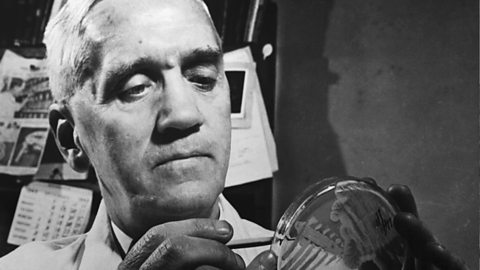The first antibiotic
Before antibioticsSubstances that control the spread of bacteria in the body by killing them or stopping them reproducing. a simple infection could be fatal if it spread throughout the body. Louis PasteurвҖҷs germ theory and Paul EhrlichвҖҷs discovery of a magic bullet were highly significant. They meant work had begun to find a natural substance that could be used to kill the bacteriaSingle-celled microorganisms, some of which are pathogenic in humans, animals and plants. Singular is bacterium. that caused infection.
Alexander Fleming

Alexander Fleming was a Scottish doctor who worked for most of his career at St MaryвҖҷs Hospital in London. In 1928, he went on holiday while researching Staphylococcus bacteria. When he tidied his laboratory after his holiday, he discovered that a mould had grown on one of his Petri dishA clear glass or plastic dish, used to grow living cells from organisms so they can be studied. The bacteria around the mould had gone.
When he investigated the mould, Fleming realised it was Penicillium fungi. He researched further and discovered that it killed Staphylococcus bacteria. He wrote about his findings in a medical journal.
Howard Florey and Ernst Chain
Howard Florey and Ernst Chain were researchers at the University of Oxford. In 1935, they used FlemingвҖҷs work as a basis for trying to purify penicillin so it could be given as a medicine. By 1941, they had managed to achieve this and were ready for a human trial.
Albert Alexander was the first person to receive penicillin, he was a policeman who had cut his cheek while gardening:
- the wound had become infected
- he was very ill in hospital
- after receiving penicillin he regained consciousness and started to recover
- there was not enough penicillin to continue treating him
- he became ill again and died
World War Two and mass production
When World War Two broke out, Florey and Chain travelled to America and were given $3 million in funding by the US government. They found a way to grow and mass produce purified penicillin. The US government paid for enough penicillin to be produced that every American soldier injured on Normandy landingsCommonly known as D-Day, it was the point that Allied forces landed in Normandy, France in June 1944, to retake Europe. could be given penicillin.
After World War Two, new methods were developed. These meant people could routinely be given antibiotics to deal with infection.